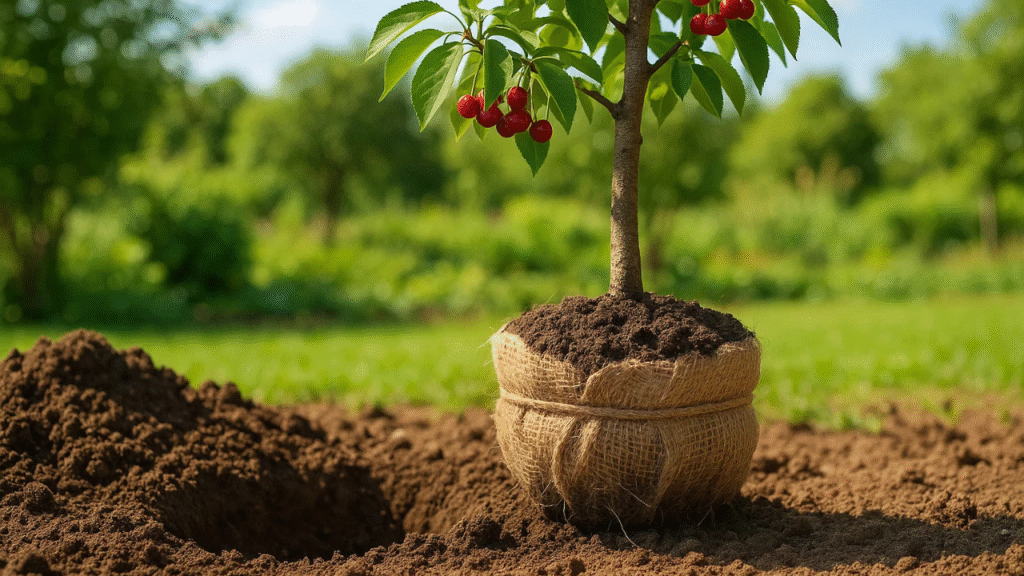
How to Handle Cherry Tree Transplant Shock and Ensure Survival: Expert Tips for Success
Transplanting a cherry tree can be a rewarding experience, but it’s not without its challenges. 🌳 When a tree is moved to a new location, it often goes through a period of adjustment, commonly known as transplant shock. If not handled correctly, this shock can stunt growth or even threaten the tree’s survival. But don’t worry—How to Handle Cherry Tree Transplant Shock and Ensure Survival is easier than you might think! In this article, we’ll share expert tips to guide you through every step of the process, from preparation to long-term care, ensuring that your cherry tree thrives in its new home. Let’s dive into how you can successfully overcome transplant shock and watch your tree flourish! 🌱
Table of Contents
ToggleUnderstanding Transplant Shock 🌿
Transplant shock occurs when a tree is moved from one location to another and struggles to adapt to its new environment. For cherry trees, this can be a serious challenge, as the roots are disturbed during the transplant process. 😟
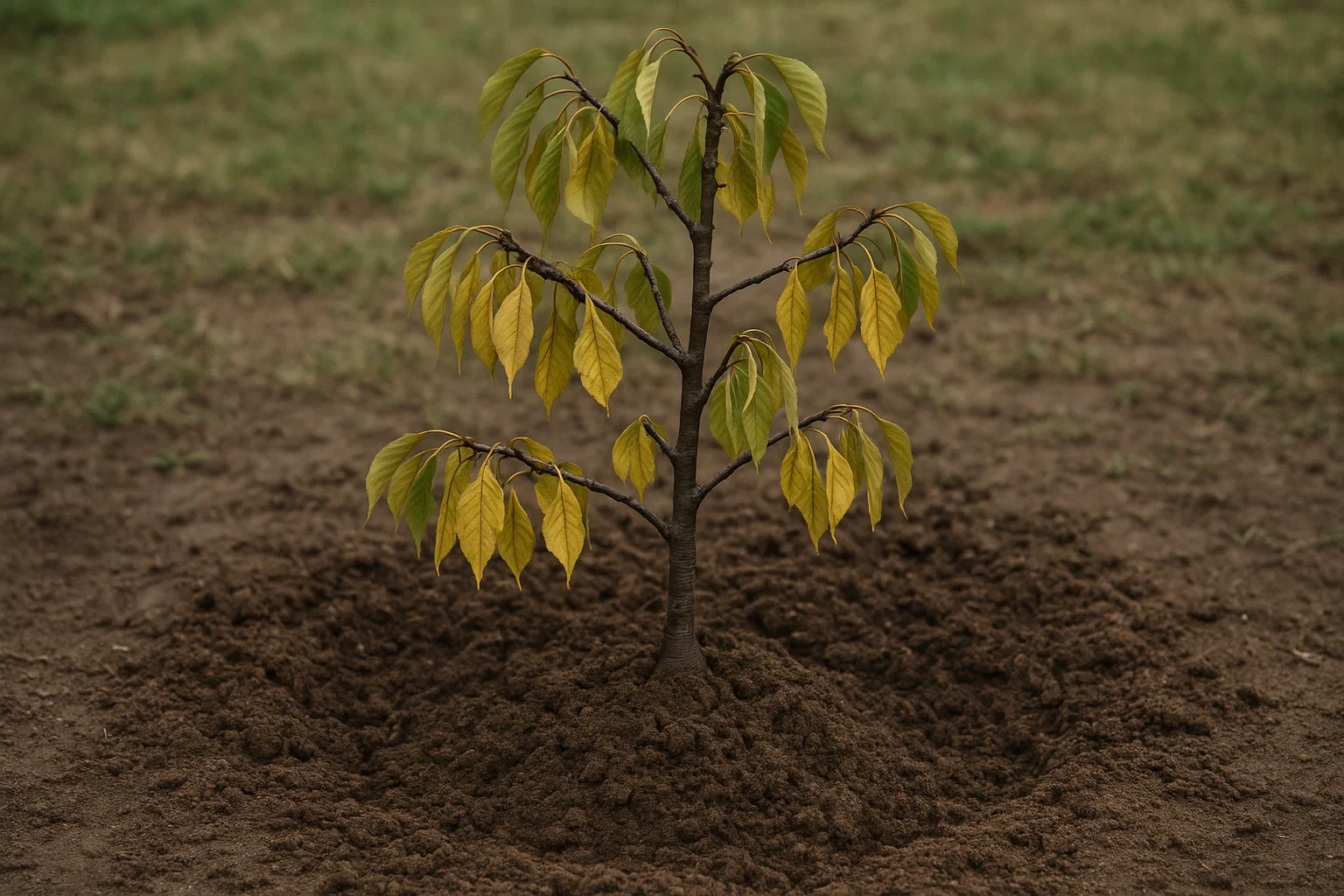
What Causes Transplant Shock?
- Root Damage: When you dig up a cherry tree, its roots can be damaged, making it harder for the tree to take in water and nutrients.
- Environmental Stress: New soil, different light conditions, and varying temperatures can all add stress to the tree.
- Improper Planting: If the tree isn’t planted at the right depth or in the right soil, it can struggle to establish itself.
Symptoms of Transplant Shock:
- Wilting Leaves: One of the first signs that something’s not right. 🌿
- Yellowing: As the tree struggles to absorb nutrients, leaves may start turning yellow. 🌞
- Stunted Growth: The tree might appear to stop growing, or growth may be much slower than expected.
Recognizing transplant shock early can help you take the right steps to save your tree and ensure it thrives. 🌱
Choosing the Right Time for Transplanting 🌱
Timing is crucial when transplanting a cherry tree. The right season can make all the difference in ensuring a smooth transition and minimizing stress. Here’s when to move your cherry tree for the best results:

Best Seasons for Transplanting Cherry Trees 🗓️
- Early Spring (before bud break): This is the ideal time. The tree is still dormant, and it has time to establish its roots before the heat of summer.
- Fall (after the growing season): This is another great option. The soil is still warm, but the tree won’t need to focus on growing leaves, allowing it to settle in before winter.
Why Timing Matters
- Avoid Hot Summers: Transplanting during the hot summer months can stress your cherry tree even further, as it will struggle to absorb enough water and may experience leaf burn. ☀️
- Cold Winters: Planting too late in fall can expose the tree to freezing temperatures before it establishes roots, risking damage.
By choosing the right time to transplant your cherry tree, you can give it the best chance to thrive in its new home. 🌳
Preparing Your Cherry Tree for Transplanting 🌿
Proper preparation is key to a successful transplant. By taking the right steps before you move your cherry tree, you can reduce transplant shock and ensure a smooth transition to its new home. Here’s how to get your tree ready:
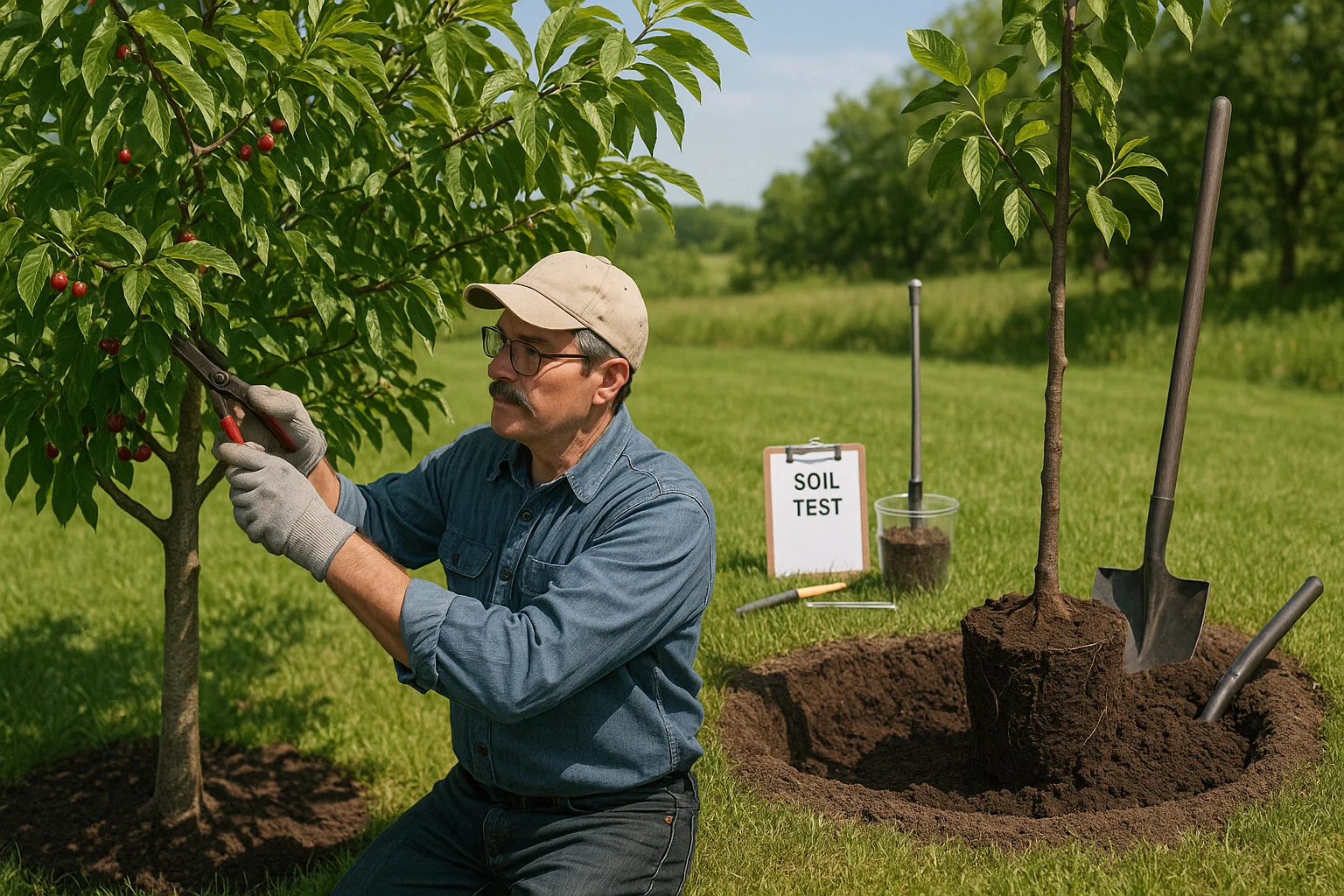
1. Select a Healthy Tree 🌳
Choose a cherry tree that is free from pests and diseases. A strong, healthy tree will be better able to handle the stress of transplanting. Look for signs of good health, like vibrant leaves and strong branches.
2. Prune Carefully ✂️
Before transplanting, lightly prune your cherry tree. Remove any dead, damaged, or diseased branches. Avoid heavy pruning, as the tree needs as many healthy leaves as possible to help it recover from the move.
3. Prepare the New Planting Site 🏡
- Soil Testing: Check the soil pH and quality in the new location. Cherry trees prefer slightly acidic, well-drained soil.
- Dig the Hole: The hole should be about 1.5 times the size of the root ball to give the roots room to spread out. Make sure the depth is just right—don’t plant too deep or too shallow.
4. Water Before Transplanting 💧
Water the tree thoroughly the day before transplanting. This will help keep the roots hydrated and reduce shock during the move.
With proper preparation, your cherry tree will have a much higher chance of survival and thrive in its new location. 🌱
Proper Transplanting Techniques 🌳
Transplanting a cherry tree properly is crucial for minimizing stress and ensuring long-term survival. Follow these steps to move your tree with care:
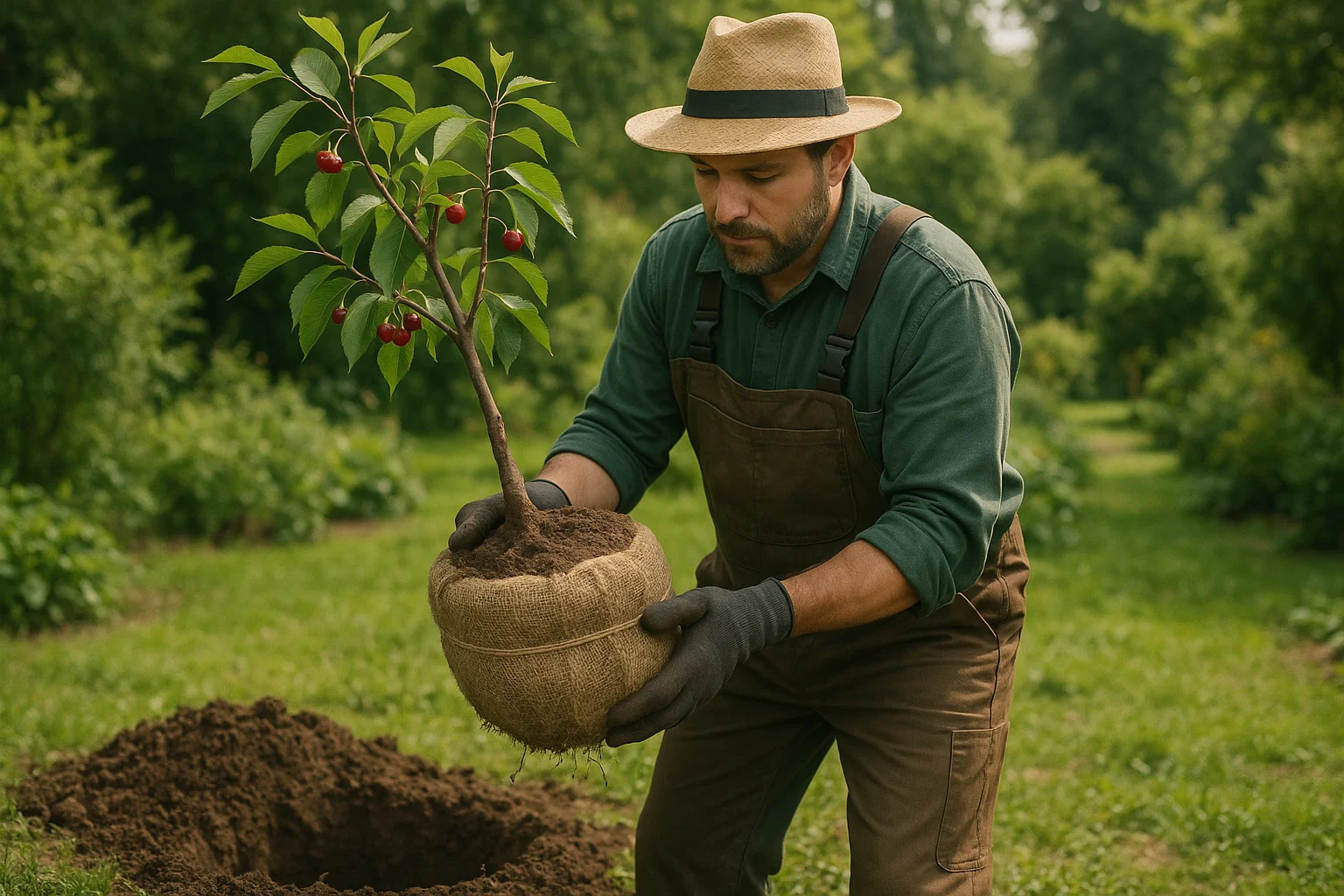
1. Digging the Tree Out ⛏️
- Preserve the Root Ball: Start by digging around the tree’s root system, ensuring you keep the root ball intact. Aim for a root ball that’s at least 12-18 inches wide for each inch of trunk diameter.
- Minimize Root Disturbance: Be gentle to avoid damaging the roots. The more roots you preserve, the better the tree will adjust.
2. Transporting the Tree 🚚
- Move Quickly: Once the tree is out of the ground, transport it to its new location as quickly as possible to avoid stress and dehydration.
- Wrap the Roots: Use burlap or a similar material to wrap the root ball and protect the roots during the move. This helps retain moisture and keeps the ball intact.
3. Planting the Tree in Its New Home 🏡
- Dig the New Hole: The new planting hole should be at least twice as wide as the root ball. It should be deep enough so the tree’s root flare (where the roots meet the trunk) is level with or slightly above the surrounding soil.
- Position the Tree: Place the tree in the hole carefully, ensuring it stands straight and doesn’t tilt. Avoid planting too deep or shallow.
- Backfill the Hole: Fill the hole with the soil you removed, gently pressing it down to remove air pockets. Water generously to settle the soil around the roots.
4. Watering Immediately 💧
After planting, water the tree thoroughly to ensure the soil around the roots is moist. This helps with settling and eliminates air pockets, which can stress the roots.
By following these transplanting techniques, your cherry tree will have the best possible start in its new home! 🌿
Watering Your Transplanted Cherry Tree 💧
Proper watering is crucial for helping your cherry tree recover from transplant shock and establish strong roots. Here’s how to water your transplanted cherry tree for optimal growth:
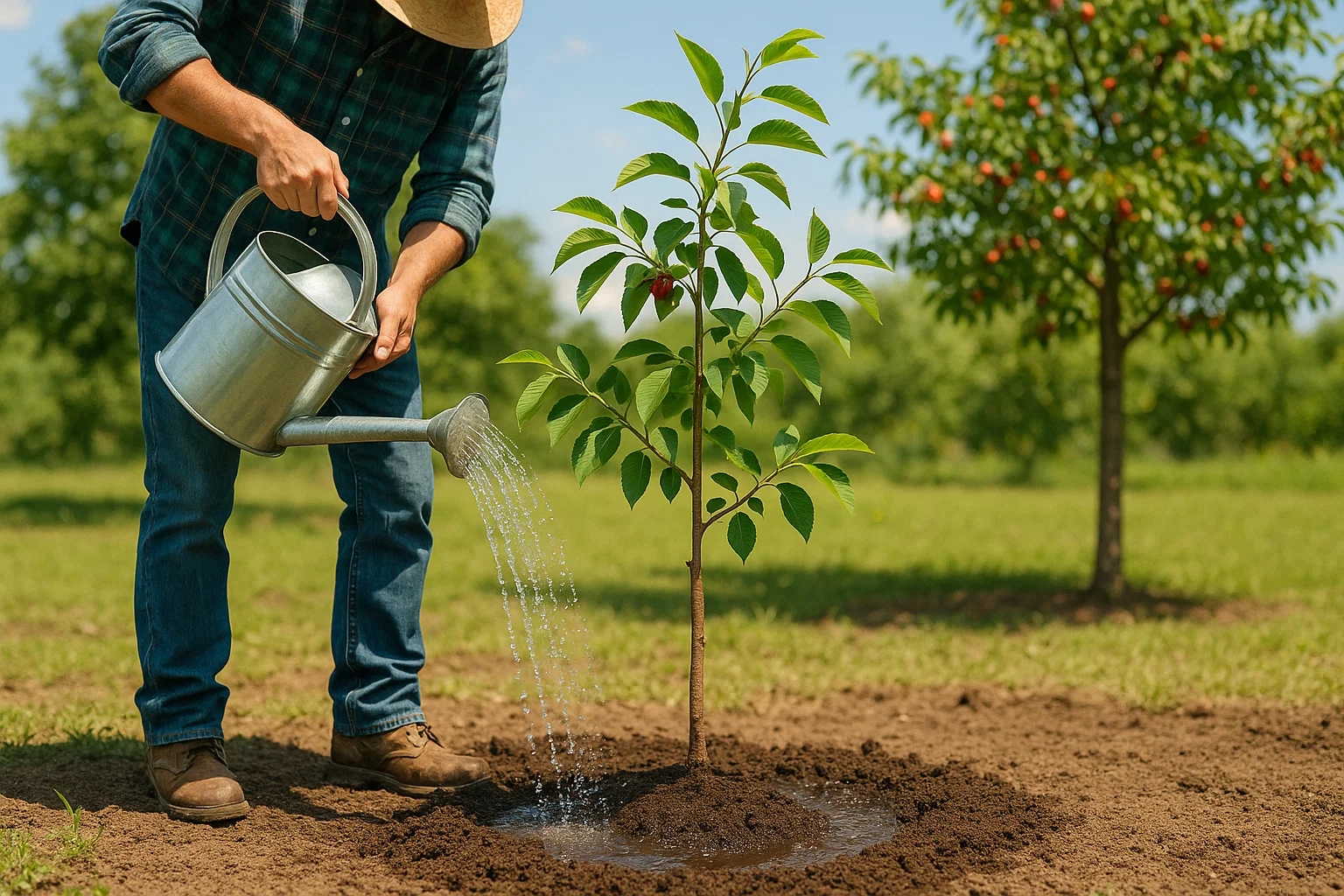
1. Water Immediately After Planting 🌱
Once your cherry tree is planted, water it thoroughly to help the roots settle into the new soil. Aim to water deeply, soaking the root ball and surrounding soil. This will help eliminate air pockets and ensure the tree has the moisture it needs to adjust.
2. Establish a Deep Watering Routine 💦
- Water Deeply, Not Frequently: Water the tree deeply at the base, ensuring the moisture reaches the root zone. Shallow watering can lead to weak roots. Aim for about 2-3 inches of water per week, depending on weather conditions.
- Avoid Overwatering: While it’s important to keep the soil moist, be careful not to overwater, as this can lead to root rot. Check the soil moisture regularly by sticking your finger about 2 inches into the soil. If it’s dry, it’s time to water.
3. Monitor During the First Few Weeks 🗓️
In the first few weeks after transplanting, your cherry tree will need more frequent watering as it recovers. Keep a close eye on the tree, especially during hot or windy weather, which can dry out the soil quickly.
4. Mulch to Retain Moisture 🌿
Apply a 2-3 inch layer of mulch around the base of the tree. Mulch helps retain moisture, regulate soil temperature, and prevent weed growth. Just make sure to keep the mulch away from the tree trunk to prevent rot.
5. Gradually Reduce Watering ⏳
As your cherry tree settles in and begins to grow, gradually reduce the watering frequency. Once it’s established, it will require less water and be more resistant to stress.
By following these watering tips, you’ll help your transplanted cherry tree thrive and establish a healthy root system in its new home. 🌳💧
Protecting the Tree from Stressors After Transplanting 🌬️
Transplanting can be a stressful experience for a cherry tree, but with the right care and protection, you can help it bounce back stronger. Here’s how to shield your tree from external stressors and ensure it settles into its new environment:
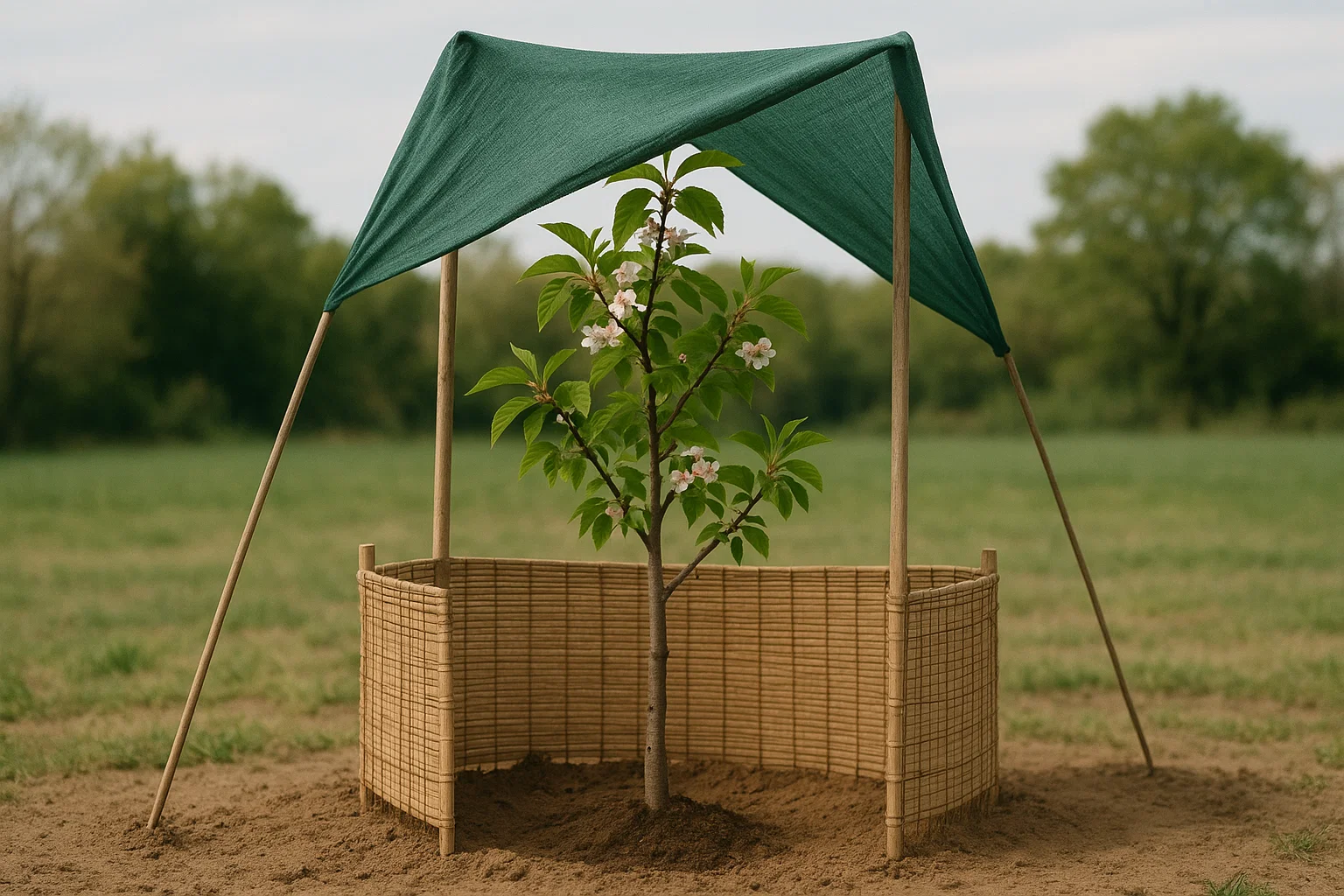
1. Provide Shade from Harsh Sunlight 🌞
Newly transplanted trees are vulnerable to sunburn and dehydration. Protect your cherry tree from intense sunlight, especially in the first few weeks, by providing temporary shade. You can use a shade cloth or create a small shelter using garden fabric to shield the tree from direct sun for a few hours each day.
2. Shield from Strong Winds 🌬️
Wind can cause dehydration and physical damage to the tree. Use stakes or a windbreak (like a temporary fence or barrier) to protect your cherry tree from strong winds. This will help prevent excessive water loss and give the tree time to acclimate to its new surroundings.
3. Mulch to Regulate Soil Temperature 🌿
Adding a 2-3 inch layer of mulch around the base of your cherry tree will help maintain consistent soil moisture and temperature. Mulch also reduces weed competition, which can drain nutrients and water away from the tree.
4. Avoid Fertilizing Immediately 🚫
Although fertilization is important for tree health, applying fertilizer too soon after transplanting can stress your cherry tree further. Wait until the tree begins to show new growth, which typically occurs in spring, before adding any fertilizer. This will help avoid over-stimulating the tree.
5. Limit Root Disturbance 🌱
Once the tree is planted, avoid disturbing the roots. This includes not overhandling the tree or its root system, and being careful when mowing or working around the planting area. Excessive disturbances can hinder root development and delay recovery.
By protecting your cherry tree from these common stressors, you’ll give it the best chance to recover quickly and establish a healthy root system. 🌳
Monitoring and Addressing Post-Transplant Symptoms 👀
After transplanting, it’s essential to keep a close eye on your cherry tree for any signs of stress or distress. Early intervention can help prevent further complications and ensure a smoother recovery. Here’s how to monitor your tree’s health and address any symptoms of transplant shock:
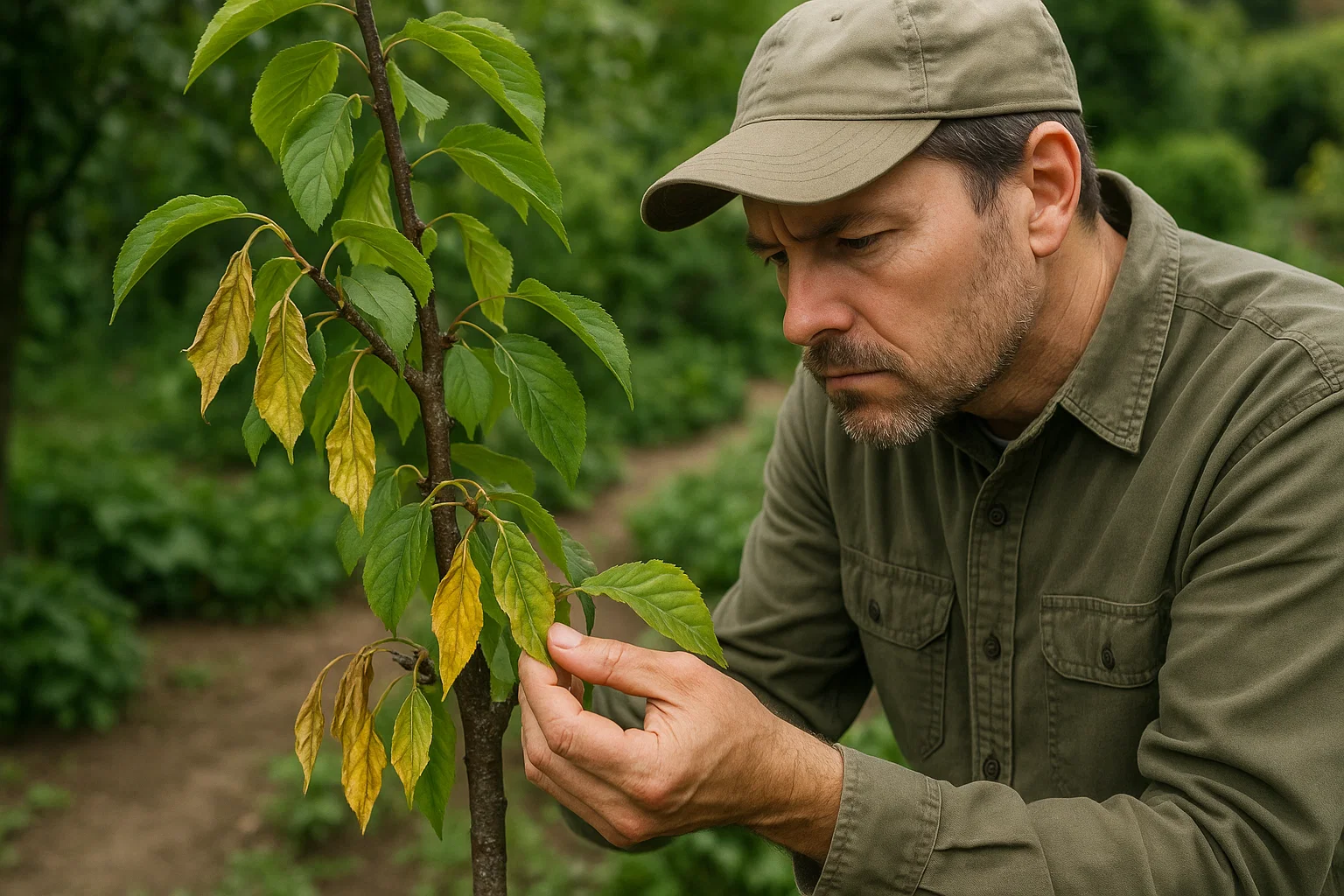
1. Check for Signs of Stress 🌿
- Wilting Leaves: If the leaves are wilting, this could be a sign of dehydration or root damage. Ensure the tree is receiving enough water, and check the soil moisture regularly.
- Yellowing Leaves: Yellow leaves can indicate nutrient deficiencies, often due to root disturbance. This is common after transplanting, but if it persists, it may suggest a more serious issue like poor soil drainage or overwatering.
- Slow or Stunted Growth: If your tree isn’t growing as expected, it might still be adjusting to its new location. Be patient, but keep monitoring the tree for any signs of deterioration.
2. Adjust Watering Practices 💧
If you notice signs of dehydration, such as wilting or dry soil, increase watering. However, avoid overwatering, as soggy soil can lead to root rot. Make sure to water deeply, ensuring moisture reaches the root zone without waterlogging the soil.
3. Look for Root Damage 🛠️
Carefully inspect the base of the tree to see if any roots are exposed or damaged. If you suspect root rot, gently dig around the tree and check for foul odors or mushy roots. In such cases, pruning the affected roots and improving drainage can help.
4. Add Mulch if Necessary 🌾
If the soil is drying out too quickly, add more mulch around the base of the tree. This will help retain moisture, regulate temperature, and protect the roots from excessive stress. Avoid piling mulch directly against the trunk to prevent rot.
5. Be Patient ⏳
Recovering from transplant shock takes time. Cherry trees typically show signs of new growth after a few weeks to a few months. During this time, continue providing proper care, and avoid disturbing the tree. Patience is key!
By monitoring these symptoms and taking quick action when necessary, you’ll help your cherry tree recover and thrive in its new home. 🌱
When to Expect Growth and How to Be Patient ⏳
Transplanting can be a stressful event for your cherry tree, and it may take some time for it to fully adjust to its new home. Patience is key, but knowing when to expect growth can help you manage your expectations and keep you motivated. Here’s what you need to know:

1. The Recovery Timeline 🗓️
- First Few Weeks: After transplanting, your cherry tree will focus on recovering from root damage and establishing itself in the new soil. You might not see much visible growth during this period, but the roots are busy growing and adapting.
- 1-3 Months: By this time, your cherry tree should show signs of recovery, like the emergence of new leaves or branches. Keep the watering consistent and protect it from environmental stressors.
- 6 Months to a Year: Once the tree has fully adjusted to its new location, you should see steady growth. Depending on the tree’s age and health, it may take up to a year to fully bounce back from transplant shock.
2. Signs of Recovery 🌱
- New Growth: Look for new leaves, buds, and branches. This is a clear sign that the tree is adjusting well.
- Stronger Roots: As the roots establish themselves, the tree will become more resilient to stress and will start growing more vigorously.
- Improved Color: If the leaves begin to turn green and healthy again, it indicates that the tree is getting the nutrients and water it needs.
3. Be Patient and Avoid Over-Caring 🌿
While it’s tempting to fertilize or prune heavily to encourage growth, overdoing it can stress the tree further. Stick to a steady watering routine and let the tree naturally regain its strength. Over-caring can lead to complications, such as root damage or nutrient imbalances.
4. Long-Term Patience ⏳
Remember that cherry trees are slow to establish themselves. Even though you might not see immediate growth, your tree is still working hard to adapt. Give it time—within a year, your cherry tree should be stronger and ready to thrive in its new environment.
By practicing patience and allowing the tree the time it needs to recover, you’ll enjoy watching your cherry tree flourish in the seasons to come. 🌳💚
Expert Tips for Long-Term Cherry Tree Health 🌳
Once your cherry tree has successfully settled into its new home, it’s important to provide the care it needs to thrive long-term. Here are some expert tips to ensure your cherry tree stays healthy, strong, and productive for years to come:

1. Regular Pruning for Healthy Growth ✂️
- Remove Dead or Diseased Branches: Pruning not only helps maintain the shape of the tree but also removes any dead, damaged, or diseased branches. This allows for better airflow and sunlight penetration, promoting healthier growth.
- Light Annual Pruning: Focus on removing any overcrowded branches to prevent disease and encourage strong, upright growth. Always prune during the tree’s dormant season (late winter or early spring).
2. Fertilize Appropriately 🌿
- Avoid Over-Fertilizing: While it’s important to fertilize cherry trees, overdoing it can lead to excessive, weak growth. Use a balanced, slow-release fertilizer in early spring, following the manufacturer’s instructions for application.
- Organic Matter: Adding organic compost or mulch around the base of your tree can provide a slow, steady release of nutrients without the risk of over-fertilization.
3. Water Deeply and Consistently 💧
- Deep Watering: Continue watering deeply, especially during dry spells. This encourages the roots to grow deeper into the soil, making your tree more resilient to drought.
- Watering Schedule: Early morning or late evening is the best time to water to minimize evaporation. During the growing season, make sure the soil stays moist but not soggy.
4. Monitor for Pests and Diseases 🐛
- Early Detection: Regularly check your cherry tree for common pests like aphids, spider mites, and cherry fruit flies. Early detection allows you to treat problems before they become major issues.
- Disease Prevention: Keep an eye out for fungal diseases such as powdery mildew and cherry leaf spot. Applying fungicides or removing affected leaves can help control spread.
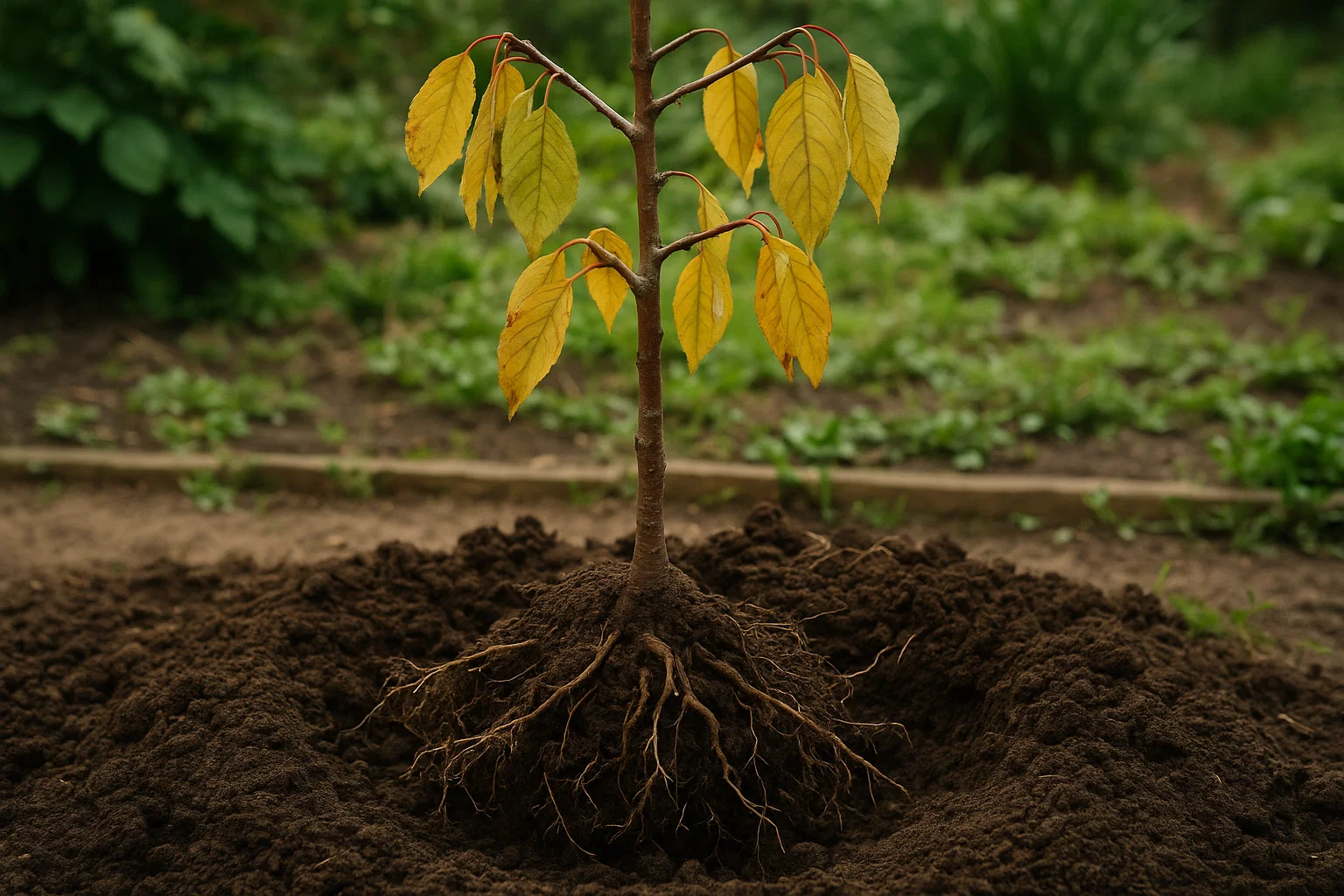
5. Mulch to Retain Moisture and Protect Roots 🌾
- Add Mulch: A layer of organic mulch around the base of the tree helps retain moisture, reduce weed competition, and maintain a consistent root temperature. Be sure to keep the mulch a few inches away from the trunk to prevent rot.
- Replenish Mulch Annually: As the mulch breaks down over time, add more to keep the root zone protected.
6. Prevent Stress During Extreme Weather 🌞❄️
- Shade in Summer: In extremely hot weather, provide some temporary shade to protect the tree from sunburn. This is especially important during the first few years after transplanting.
- Winter Protection: In colder climates, protect your cherry tree from freezing temperatures by wrapping the trunk with burlap or using tree guards. This prevents damage from frost and winter winds.
7. Regularly Assess Soil Health 🌱
- Test Soil pH: Cherry trees thrive in slightly acidic soil (pH 6.0-6.5). Testing your soil every couple of years will help you understand its pH and nutrient levels, ensuring the tree has the proper growing conditions.
- Amend Soil When Necessary: If the soil is too alkaline, you can amend it with sulfur or organic matter to improve acidity.
8. Be Patient and Let the Tree Mature ⏳
Cherry trees take time to reach their full potential, so patience is key. While it may take several years to produce fruit, the long-term health of your tree will be worth the wait. By following these expert tips and consistently caring for your tree, you’ll ensure that it remains healthy and productive for many years to come. 🌳💚
By investing in your cherry tree’s long-term care, you’ll enjoy its beauty and fruit for years to come, making it a valuable addition to your garden or landscape. 🌸
Final Thoughts 🌱
Transplanting a cherry tree can be a challenging yet rewarding experience. With the right care and attention, you can successfully overcome transplant shock and help your tree thrive in its new home. By following the expert tips shared in this article—from proper planting techniques to protecting the tree from stressors and monitoring its recovery—you can ensure that your cherry tree grows strong, healthy, and fruitful for years to come. 🌳
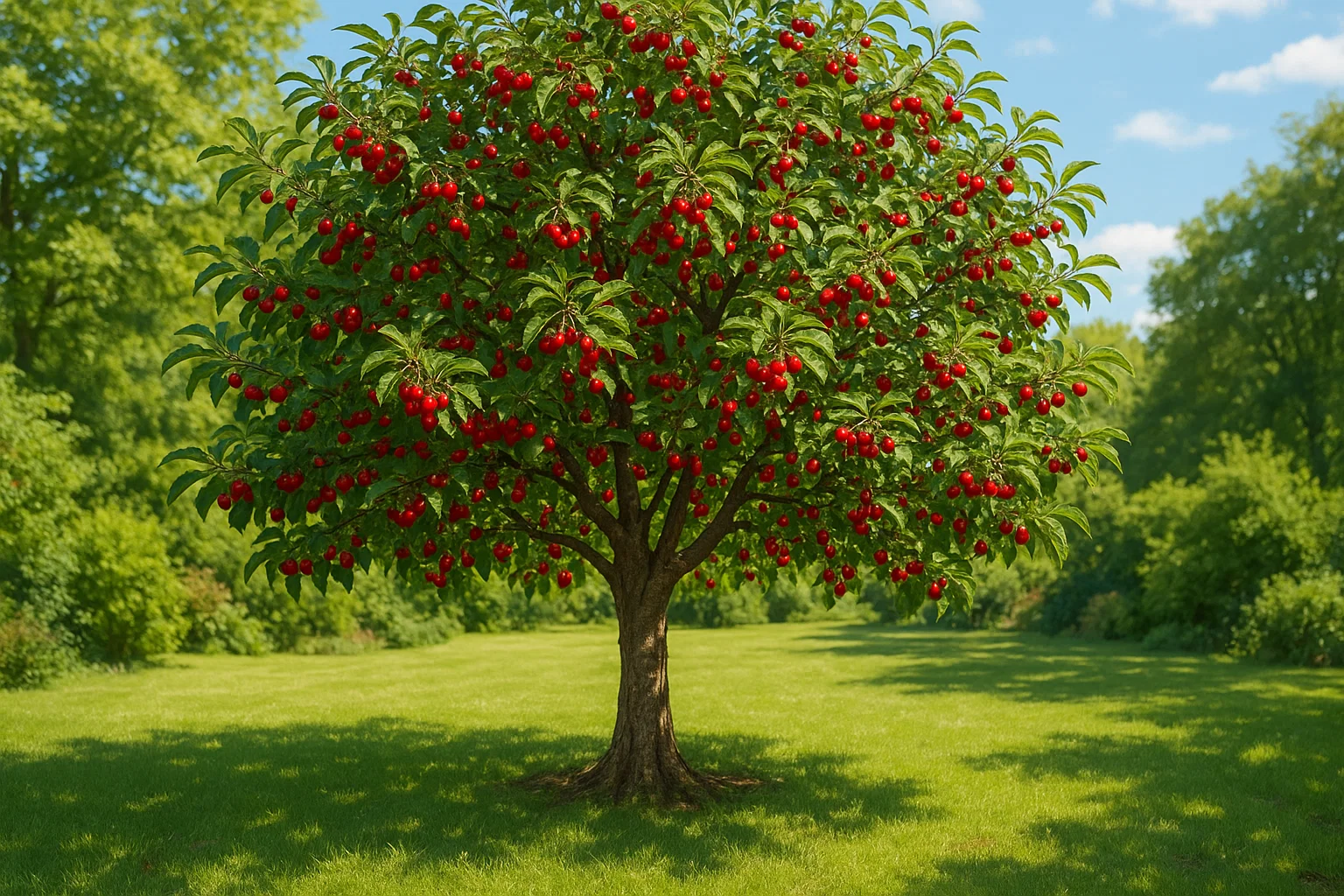
Remember, patience is key. It may take time for your tree to fully adjust, but with consistent care, your cherry tree will reward you with vibrant growth and, eventually, beautiful blooms and delicious fruit. 🌸🍒
Happy planting, and may your cherry tree flourish in its new home! 🌱🌿
Frequently Asked Questions (FAQ)
What is transplant shock in cherry trees?
Transplant shock occurs when a cherry tree experiences stress after being moved from its original location to a new one. It can affect the tree’s growth and health, causing symptoms like wilting, yellowing leaves, or stunted growth. This shock is typically due to the disturbance of the roots, change in soil, and environmental differences.
How can I prevent transplant shock when moving a cherry tree?
To prevent transplant shock, ensure you dig a large root ball with as many roots as possible, water the tree well before and after transplanting, and avoid disturbing the roots too much. Transplant during cooler weather (spring or fall) to reduce stress, and choose a suitable location with well-drained soil.
What are the common signs of transplant shock in cherry trees?
Signs of transplant shock include wilting, yellowing or browning of the leaves, slow or halted growth, leaf drop, and brown spots. The tree may appear stressed for weeks or even months after being transplanted.
How long does transplant shock last for cherry trees?
Transplant shock can last anywhere from a few weeks to several months, depending on the tree’s age, size, and how well it’s cared for. Younger trees tend to recover faster than older ones. It’s important to be patient and continue caring for the tree during this time.
How do I care for a cherry tree after transplanting it?
After transplanting, water the tree deeply and regularly, especially during dry spells. Mulch around the base to retain moisture and protect the roots. Avoid fertilizing immediately after transplanting, as the tree needs time to adjust. Prune only dead or damaged branches to reduce stress.
Should I prune a cherry tree right after transplanting?
It’s generally best to avoid pruning a cherry tree immediately after transplanting unless you need to remove dead or damaged branches. Pruning too soon can add extra stress, and the tree needs all its energy to establish new roots in its new location.
How often should I water a cherry tree after transplanting?
Water the tree deeply right after transplanting, and continue to water regularly for the first few weeks. Check the soil moisture by inserting your finger 2-3 inches into the soil. If it’s dry, it’s time to water. Avoid waterlogging but keep the soil consistently moist to help the tree establish its roots.
Can a cherry tree survive transplant shock?
Yes, most cherry trees can survive transplant shock with proper care. By ensuring adequate watering, preventing further stress, and providing the right conditions, the tree should gradually recover. It may take time, but with patience and attention, your cherry tree can thrive in its new location.
